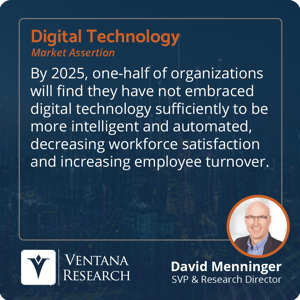Automation uses technology to perform tasks or functions that would otherwise require human intervention or effort. Automation has existed for decades, and it takes many forms. It handles routine tasks, freeing time for knowledge workers to perform other activities that require creativity, subjectivity or empathy. Automation can also improve the quality, efficiency and consistency of business processes as well as enhance customer satisfaction and brand loyalty.
As a CIO or IT leader, you are constantly looking for ways to optimize business processes and outcomes while reducing costs, risks and errors. You are also aware of the increasing demands and expectations of your  customers, workforce and stakeholders who want faster, better and more personalized services and approaches. You know that technology can be a powerful enabler for achieving these goals, but you also face the challenges of integrating, managing and scaling complex and diverse systems and data sources. Plus, you must do all of this with limited resources and constrained budgets. The challenge is so great that we assert that by 2025, one-half of organizations will find they have not embraced digital technology sufficiently to be more intelligent and automated, decreasing workforce satisfaction and increasing employee turnover.
customers, workforce and stakeholders who want faster, better and more personalized services and approaches. You know that technology can be a powerful enabler for achieving these goals, but you also face the challenges of integrating, managing and scaling complex and diverse systems and data sources. Plus, you must do all of this with limited resources and constrained budgets. The challenge is so great that we assert that by 2025, one-half of organizations will find they have not embraced digital technology sufficiently to be more intelligent and automated, decreasing workforce satisfaction and increasing employee turnover.
How can you overcome these challenges and unlock the full potential of technology for your organization? The answer is intelligent automation.
Automation is not one thing and is classified in different types based on complexity, intelligence and human involvement. Some of the most common and widely used forms of automation are:
- Interactive voice response, which allows users to interact with a computer system through voice or keypad inputs. Applied in customer service and contact centers to provide automated responses, information or guidance to callers, IVR can also route calls to the appropriate agent or department. An effective IVR system reduces customer waiting time and frustration and the workload and cost of human agents.
- Statistical process control, a method of monitoring and controlling the quality and performance of a process or product using statistical tools and techniques. SPC is often found in manufacturing and quality assurance to detect and prevent defects, errors or variations in the production process or to ensure that the product meets specifications and standards. SPC reduces waste and rework. The method can improve the efficiency, reliability and consistency of the process or product.
- Rules-based automation, which follows predefined rules or logic to perform tasks or functions. RBA is often used in finance, accounting and compliance to automate repetitive or routine tasks such as data entry, validation, reconciliation, calculation, reporting or auditing. RBA increases the speed, accuracy and productivity of tasks or functions. It has shown results in reducing human errors and risks.
- Straight-through processing, which enables end-to-end transaction processing and workflows without manual intervention or verification. STP is used by banking, insurance and e-commerce to automate transactions or workflows such as payments, transfers, claims, orders or deliveries. A benefit observed for STP is a reduction in operational costs and errors. STP enhances the customer experience and satisfaction by providing faster, smoother and more convenient services or approaches.
- Robotic process automation, using software robots or digital workers to mimic human actions or behaviors to perform tasks or functions. RPA is used in data entry, invoice processing, report generation and other tasks and functions that require interacting with multiple applications or systems. RPA can automate complex and high-volume tasks or functions prone to human errors or delays, freeing up human workers for higher-value activities.
These are examples of automation organizations use to optimize business processes and outcomes. However, automation is not a static or one-size-fits-all concept. It is constantly evolving and advancing with the development of new technologies and innovations. In a separate perspective, I will examine the role of AI in intelligent automation. The evolution of automation to benefit organizations and the workforce helps unlock the full potential of technology and achieve business goals.
Regards,
Jeff Orr

 customers, workforce and stakeholders who want faster, better and more personalized services and approaches. You know that technology can be a powerful enabler for achieving these goals, but you also face the challenges of integrating, managing and scaling complex and diverse systems and data sources. Plus, you must do all of this with limited resources and constrained budgets. The challenge is so great that we assert that by 2025, one-half of organizations will find they have not embraced digital technology sufficiently to be more intelligent and automated, decreasing workforce satisfaction and increasing employee turnover.
customers, workforce and stakeholders who want faster, better and more personalized services and approaches. You know that technology can be a powerful enabler for achieving these goals, but you also face the challenges of integrating, managing and scaling complex and diverse systems and data sources. Plus, you must do all of this with limited resources and constrained budgets. The challenge is so great that we assert that by 2025, one-half of organizations will find they have not embraced digital technology sufficiently to be more intelligent and automated, decreasing workforce satisfaction and increasing employee turnover.








